Europe Less-than Container Load (LCL) Market Size
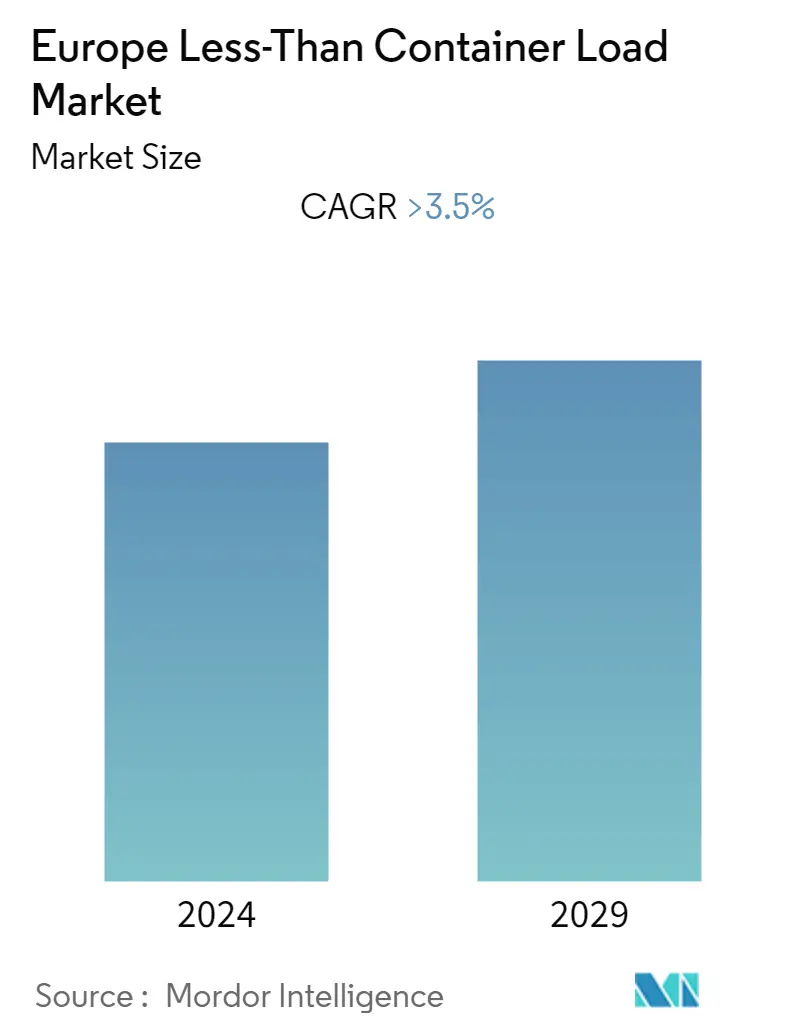
| Study Period | 2020 - 2029 |
| Base Year For Estimation | 2023 |
| Forecast Data Period | 2024 - 2029 |
| Historical Data Period | 2020 - 2022 |
| CAGR | 3.50 % |
| Market Concentration | Low |
Major Players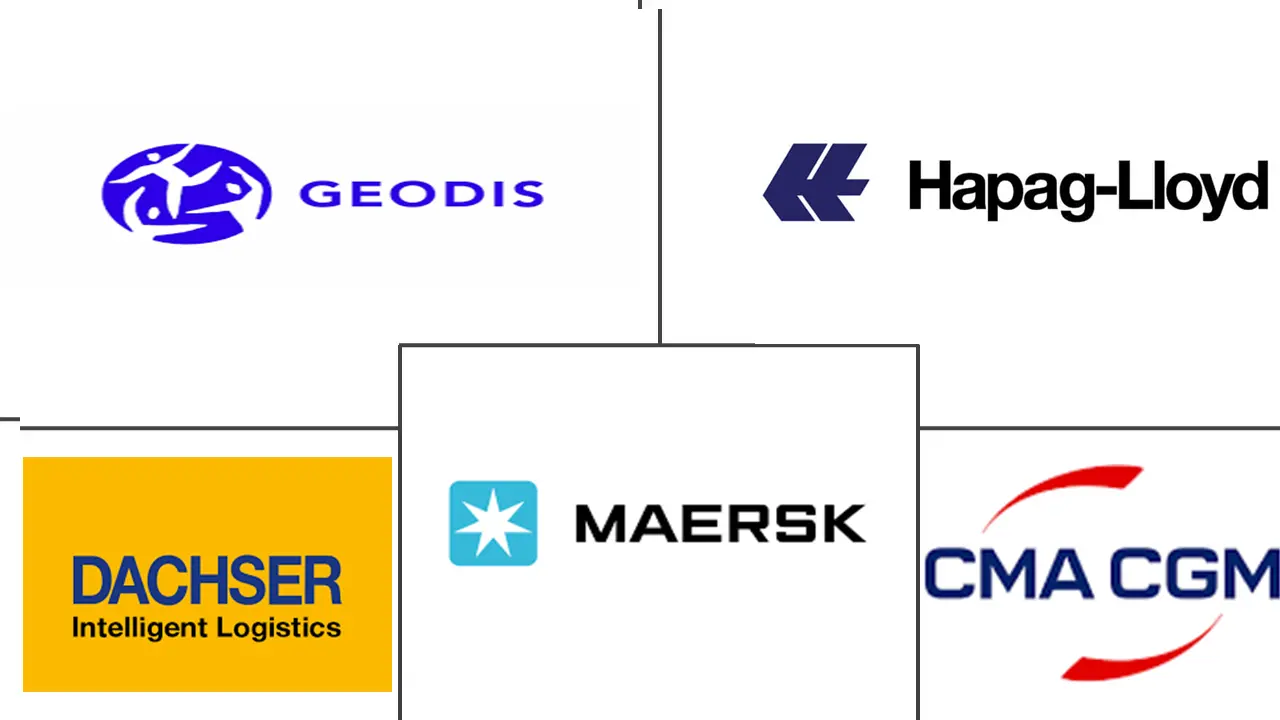
*Disclaimer: Major Players sorted in no particular order |
Europe Less-than Container Load (LCL) Market Analysis
From 2022 to 2027, the Europe Less-than Container Load sector is expected to be a CAGR of greater than 3.5 percent.
The ongoing worldwide Coronavirus (COVID-19) outbreak is affecting global shipping, affecting all sectors from passenger ships to container ships and oil tankers. In order to secure cargo, the shipping sector is completely reliant on manufacturing output. The coronavirus epidemic has put a strain on the shipping industry, with lockdowns and closed facilities.
In March 2020, the coronavirus outbreak in Europe reached new heights, having a devastating impact on health, people, and the economy. The European Union responded to COVID-19's outbreak and its effects by adopting a wide range of policies in a variety of sectors (health, economy, research, border, mobility, etc.). Since the beginning of the COVID19 issue, the Commission, Member States, and the shipping sector have taken steps to assure operational continuity and, as a result, supply security.
According to an analysis of ship calls at EU ports, the number of ship calls at EU ports decreased by 30% in 2020 compared to 2019. When compared to the same month in 2019, the number of ship calls in April 2021 declined by 4%. Cruise ships, passenger ships, refrigerated cargo ships, and vehicle carriers have been the most severely hit sectors. In the meantime, the number of Ro-Ro Passenger boats increased by 8%.
Croatia, Cyprus, Finland, France, Latvia, Norway, Portugal, and Spain are the countries most impacted.
Europe Less-than Container Load (LCL) Market Trends
This section covers the major market trends shaping the Europe Less-than Container Load Market according to our research experts:
Sales of E-commerce in Europe
The expansion of the less-than-containerload (LCL) sector of the market appears to be driven by smaller and more precise consignments, more frequent shipping, increased demand for e-commerce, and improved availability of supply chain data. While Eastern Europe saw stronger growth rates in 2021, Western Europe maintained its position in turnover with 63 percent. In comparison, Eastern Europe accounts for only 2% of overall European e-commerce income. Northern Europe had the biggest percentage of online shoppers (86%) for the first time, followed by Western Europe (84 percent). The Netherlands has the most internet consumers (94 percent), followed by Denmark and Sweden (both 92 percent).
Across the major trades, there was a significant increase in the number of customers requiring LCL cargo shipments, and while the reasons for this increased demand varied, it appears that the changing nature of trade flows and an evolving supply chain have created an environment where shipping smaller consignments more frequently makes sense.
Technology aids in the improvement of freight movement and the tracking of timestamps. Furthermore, in terms of combining client-specific consolidation and LCL, the better the data, the better the utilization management and solution creation for consumers.
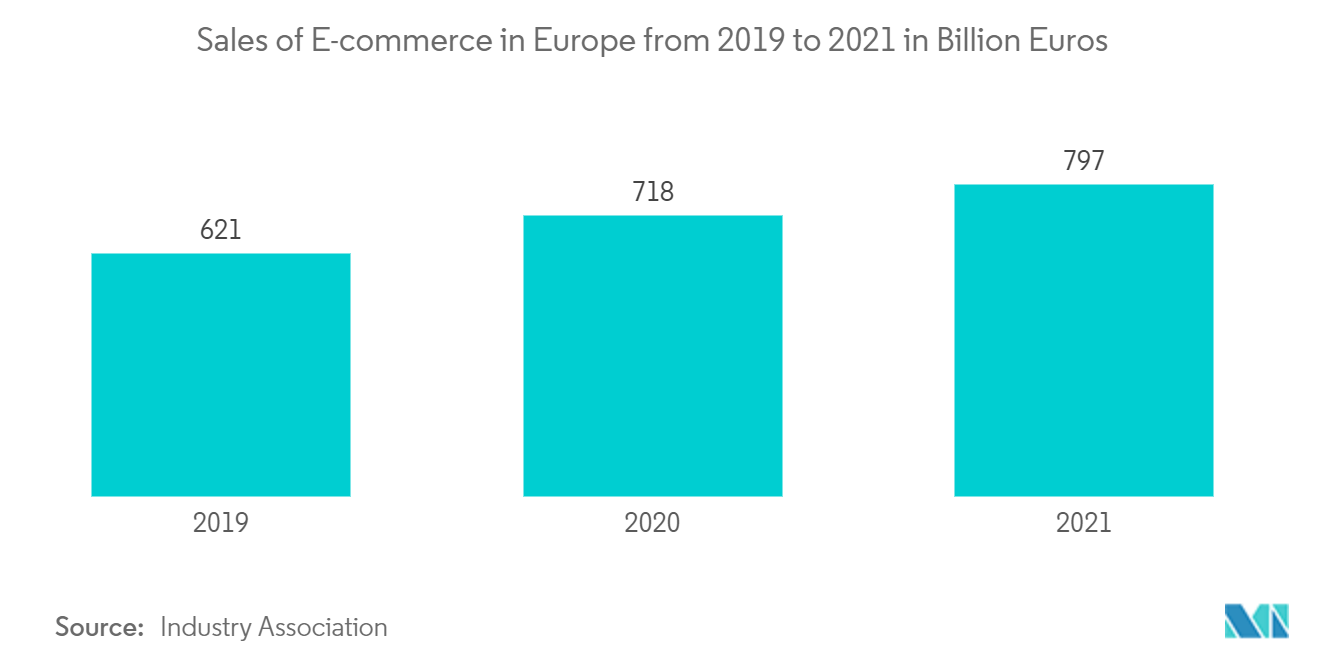
Boosting Maritime Trade
The maritime cargo sector is seeing an increase in demand for cargo transportation via waterways, driven by considerations such as container safety and cost-effectiveness. Cargo ships are less costly than road and air transits for shipping commodities. Ships can transport more goods from one location to another in a shorter amount of time.
With over 80% of global commercial commerce handled by sea, maritime transport is the backbone of international trade and globalization. For the EU, which remains the world's largest exporter and second-largest importer, marine transport and all connected shipping services are critical to assisting European enterprises in competing worldwide.
The European Commission conducts an ongoing conversation with all of the EU's shipping and trading partners across the world, including the United States, China, India, Japan, and Russia, to strengthen the global seaborne trade system's stability. Bilateral agreements and talks are critical tools for resolving issues, removing barriers to international marine trade, and promoting great shipping ideals across the world.
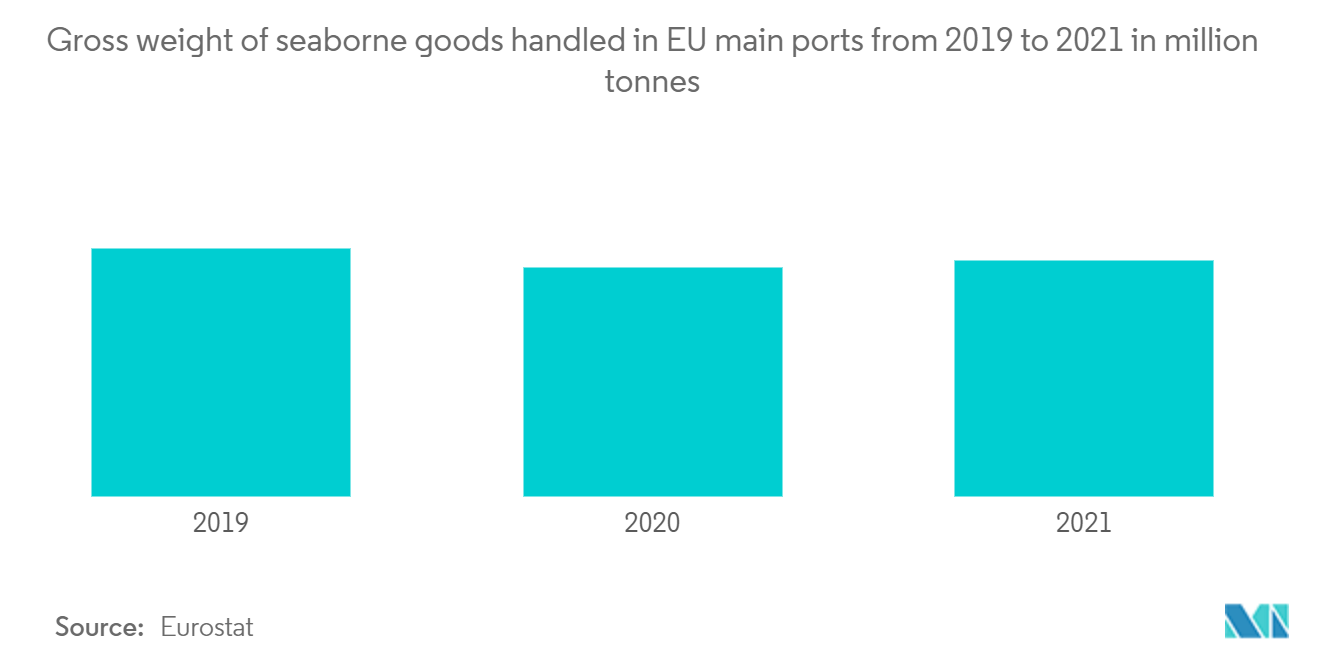
Europe Less-than Container Load (LCL) Industry Overview
Shippers are willing to pay premium rates on significant trades to ensure space in a market disturbed by maxed-out air capacity and crowded ocean freight, according to forwarders reporting double-digit percentage growth in less-than-containerload (LCL) traffic.
As carriers warn of significant equipment shortages on trades out of Asia through May, especially on the trans-Pacific, where US import demand has been robust for months, demand for consolidated cargo, which demands a premium price above full containerload (FCL) cargoes, is projected to grow even more. Soaring prices on the trans-Pacific and Asia-Europe air and ocean trades make LCL services a high-margin industry, with several consignees crammed into a single container.
The top players in the segment include Maersk, GEODIS, CMA, Dachser, and Hapag Lloyd. The market started reviving from the pandemic by growing positively post-pandemic.
Europe Less-than Container Load (LCL) Market Leaders
-
MAERSK
-
The CMA CGM Group
-
Hapag-Lloyd
-
GEODIS
-
Dachser
*Disclaimer: Major Players sorted in no particular order
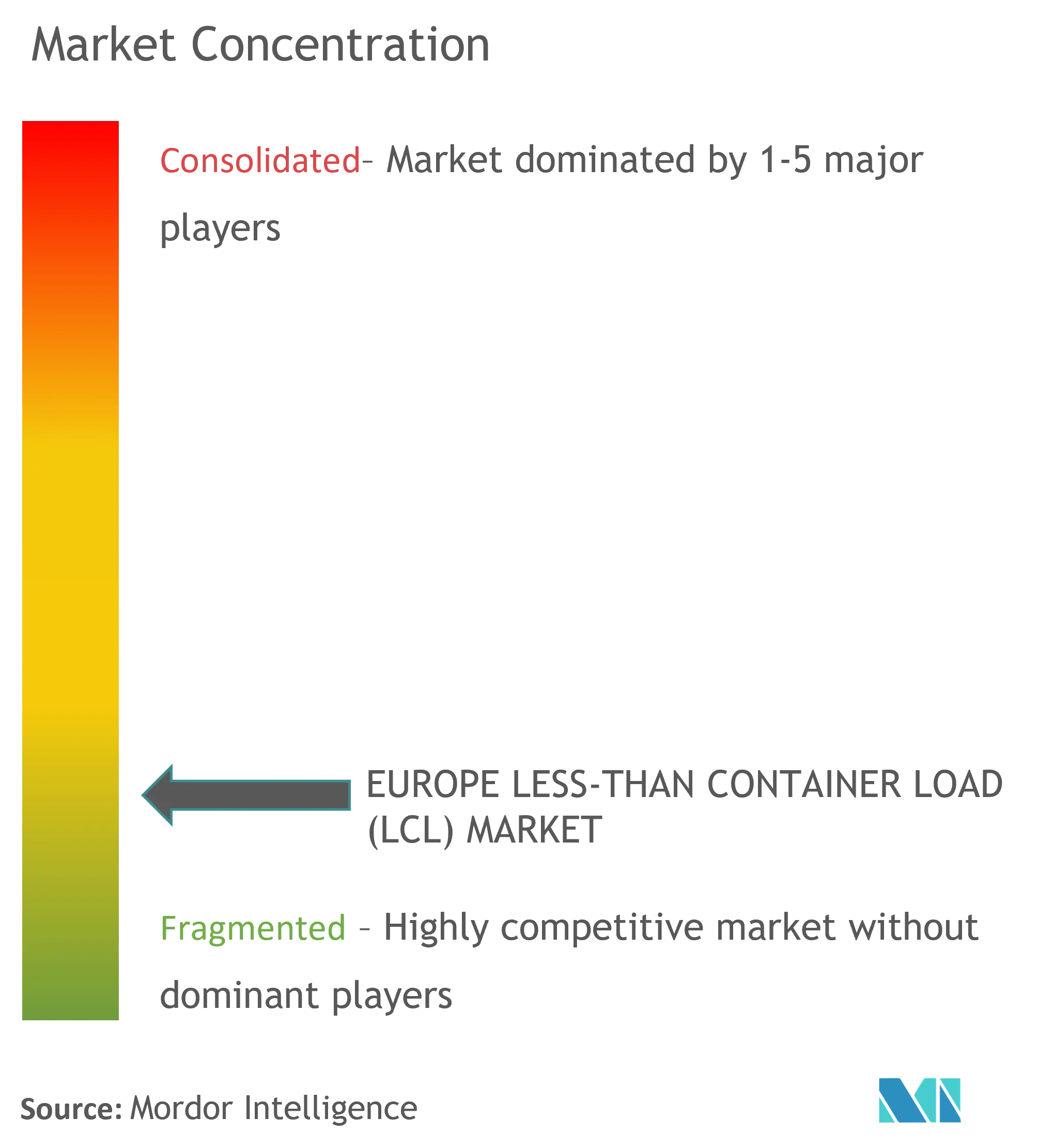
Europe Less-than Container Load (LCL) Market News
June 2022: Shippeo, a worldwide and multimodal shipment service, has teamed up with Everysens, a leader in rail and intermodal transport management solutions, to improve their multimodal transport visibility offering. Based on real-time data from satellite tracking and train operators, Everysens will give Shippeo the most reliable rail ETA available on the market. Everysens can better predict rail logistics implications by exchanging container events for maritime shipments, as well as very precise and reliable road freight ETAs.
July 2021: Allcargo Logistics Ltd,a Mumbai-based Indian logistics company wholly-owned subsidiary of Allcargo Belgium NV has signed a final joint venture agreement with Nordic Group of Sweden. Nordic Group is the Nordics' market leader in Less-Container-Load (LCL) and rail consolidation. This collaboration broadens ECU Worldwide's service network and worldwide reach by adding additional geographies and specialized rail freight consolidation services to further develop across Europe and assist in better serving clients in the Nordic area who are searching for flexible and time-bound logistics solutions.
Europe Less-than Container Load (LCL) Market Report - Table of Contents
1. INTRODUCTION
- 1.1 Study Deliverables
- 1.2 Study Assumptions
- 1.3 Scope of the Study
2. RESEARCH METHODOLOGY
3. EXECUTIVE SUMMARY
4. MARKET INSIGHTS AND DYNAMICS
- 4.1 Market Overview
- 4.2 Market Drivers
- 4.3 Market Restraints
- 4.4 Value Chain / Supply Chain Analysis
-
4.5 Porter's Five Force Analysis
- 4.5.1 Threat of New Entrants
- 4.5.2 Bargaining Power of Buyers/Consumers
- 4.5.3 Bargaining Power of Suppliers
- 4.5.4 Threat of Substitute Products
- 4.5.5 Intensity of Competitive Rivalry
- 4.6 Impact of COVID-19 on the Market
5. MARKET SEGMENTATION
-
5.1 By Destination
- 5.1.1 Domestic
- 5.1.2 International
-
5.2 By End User
- 5.2.1 Manufacturing
- 5.2.2 Retail
- 5.2.3 Healthcare and Pharmaceuticals
- 5.2.4 Agriculture
- 5.2.5 Other End Users
-
5.3 Geography
- 5.3.1 Europe
- 5.3.1.1 Germany
- 5.3.1.2 UK
- 5.3.1.3 France
- 5.3.1.4 Russia
- 5.3.1.5 Spain
- 5.3.1.6 Rest of Europe
6. COMPETITIVE LANDSCAPE
- 6.1 Market Concentration Overview
-
6.2 Company Profiles
- 6.2.1 MAERSK Shipping company
- 6.2.2 The CMA CGM Group
- 6.2.3 Hapag-Lloyd Container Shipping
- 6.2.4 GEODIS Freight Forwarding
- 6.2.5 Dachser Logistics company
- 6.2.6 Hamburg Sud Logistics company
- 6.2.7 Mediterranean Shipping Company
- 6.2.8 ECS European Containers
- 6.2.9 DHL Group
- 6.2.10 DB Schenker Logistics*
- *List Not Exhaustive
7. MARKET OPPORTUNITIES AND FUTURE TRENDS
8. APPENDIX
** Subject To AvailablityEurope Less-than Container Load (LCL) Industry Segmentation
Less than container load shipping is a cost-effective and flexible form of international cargo shipment as it allows shippers to consolidate shipments with other customers for lower rates rather than ship individual shipments on an independent basis using full container loads or truckload services. It is also known as groupage because it is grouped with other goods. As a result, LCL shipping is designed for goods with a low or moderate volume. As a result, LCL is the popular way of shipping for small firms.LCL is more commonly accessible than FCL during peak season.
The market is segmented By Destination (Domestic and International), By End User (Manufacturing, Retail (Includes E-commerce), Healthcare and Pharmaceuticals, Agriculture, and Other End Users), By Country (Germany, United Kingdom, France, Italy, Spain, Russia, Netherlands, Poland, Rest of Europe)
A full study of the Europe Less-than Container Market, including current market trends, constraints, technical updates, and extensive information on key segments and the industry's competitive landscape. During the research, the influence of COVID-19 was also taken into account.
| By Destination | Domestic | |
| International | ||
| By End User | Manufacturing | |
| Retail | ||
| Healthcare and Pharmaceuticals | ||
| Agriculture | ||
| Other End Users | ||
| Geography | Europe | Germany |
| UK | ||
| France | ||
| Russia | ||
| Spain | ||
| Rest of Europe |
Europe Less-than Container Load (LCL) Market Research FAQs
What is the current Europe Less-Than Container Load Market size?
The Europe Less-Than Container Load Market is projected to register a CAGR of greater than 3.5% during the forecast period (2024-2029)
Who are the key players in Europe Less-Than Container Load Market?
MAERSK, The CMA CGM Group, Hapag-Lloyd, GEODIS and Dachser are the major companies operating in the Europe Less-Than Container Load Market.
What years does this Europe Less-Than Container Load Market cover?
The report covers the Europe Less-Than Container Load Market historical market size for years: 2020, 2021, 2022 and 2023. The report also forecasts the Europe Less-Than Container Load Market size for years: 2024, 2025, 2026, 2027, 2028 and 2029.
Europe Less-than Container Load Industry Report
Statistics for the 2024 Europe Less-than Container Load market share, size and revenue growth rate, created by Mordor Intelligence™ Industry Reports. Europe Less-than Container Load analysis includes a market forecast outlook to 2029 and historical overview. Get a sample of this industry analysis as a free report PDF download.



